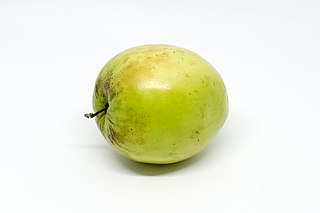
The Granny Smith is a tip-bearing apple cultivar which originated in Australia in 1868. It is named after Maria Ann Smith, who propagated the cultivar from a chance seedling. The tree is thought to be a hybrid of Malus sylvestris, the European wild apple, with the domesticated apple Malus pumila as the polleniser.

A cooking apple or culinary apple is an apple that is used primarily for cooking, as opposed to a dessert apple, which is eaten raw. Cooking apples are generally larger, and can be tarter than dessert varieties. Some varieties have a firm flesh that does not break down much when cooked. Culinary varieties with a high acid content produce froth when cooked, which is desirable for some recipes. Britain grows a large range of apples specifically for cooking. Worldwide, dual-purpose varieties are more widely grown.

The Flower of Kent is a green cultivar of cooking apple. According to the story, this is the apple Isaac Newton saw falling to ground from its tree, inspiring his laws of universal gravitation. It is pear-shaped, mealy, and sub-acid, and of generally poor quality by today's standards. As its name suggests, this cultivar likely originated from Kent, England.

The Braeburn is a cultivar of apple that is firm to the touch with a red/orange vertical streaky appearance on a yellow/green background. Its color intensity varies with different growing conditions.

Ziziphus mauritiana, also known as Indian jujube, Indian plumChinese date, Chinee apple, and dunks is a tropical fruit tree species belonging to the family Rhamnaceae.

Gala is a clonally propagated apple cultivar with a mild and sweet flavour. In 2018, it surpassed Red Delicious as the apple cultivar with the highest production in the United States, according to the US Apple Association. It was the first time in over 50 years that any cultivar was produced more than Red Delicious.

Blenheim Orange is a cultivar of apple. It was found at Woodstock, Oxfordshire near Blenheim in England in about 1740. It has been described as a cooking apple.

'Ambrosia' is a cultivar of apple originating in British Columbia in the early 1990s. The original tree was first cultivated by the Mennell family of Similkameen Valley, British Columbia, who discovered it growing in their orchard.

Golden Noble is an old English cultivar of domesticated apple, which is especially used as a cooking apple, since it is resulting in a sweetish puree when cooked and is a good choice for apple sauce.
The 'Laxton's Superb' is an apple cultivar that was developed in England in 1897. It is a cross breed between 'Wyken Pippin' and 'Cox's Orange Pippin'. It is a British apple with a green color and a dull red flush. It is a firm-textured dessert apple. The fruit is well known for its sweet and aromatic taste which is likened to the parent species it is derived from, the 'Cox's Orange Pippin'.

Bismarck is an apple cultivar. The fruit from the tree is used for cooking due to its sharp flavour and is most commonly pureed when cooking.
The Golden Spire apple was first discovered in Lancashire, England in about 1850. It was later grown in Gloucestershire where it was known as Tom Matthews and grown for cider production, although it had previously been used for both cider and eating. It can also be used for juicing and cooking.

The 'Sunset' is an apple cultivar derived from the Cox's Orange Pippin cultivar. Both are found in Great Britain. The fruit has red stripes and an orange flush over a gold background. Usually, part of the apple is red while part of it is yellow. It is similar to 'Cox's Orange Pippin' in that it displays some russetting. The 'Pixie' apple is a distant descendant.

'Akane' also known as 'Tokyo Rose', 'Tohoku No.3' and 'Prime Red' is a Japanese cultivar of domesticated apple, that according to Orange Pippin is one of the best early season apples.

'Worcester Pearmain' is an early season English cultivar of domesticated apple, that was developed in Worcester, England, by a Mr. Hale of Swanpool in 1874. It was once the most popular cultivar in England for early autumn harvest and is still popular to keep in the garden. It has been extensively used in apple breeding.

'Duchess of Oldenburg' is an old Russian cultivar of cultivated apple which has attractive streaks of yellow and red. It was commonly but not universally known in America simply as 'Oldenburg' after the American Pomological Society listed that as the official name, a name also used for the 'Geheimrat Dr. Oldenburg' cultivar. The skin of the apple is more prominently striped than that of 'Geheimrat Dr. Oldenburg'.

Golden Russet is an old American cultivar of domesticated apple which is excellent for fresh eating as well as for apple cider production. It is a russet apple and is therefore especially used as a cider apple. It is sometimes known as 'English Golden Russet', and has frequently been confused with 'English Russet'.

Winston is an English cultivar of domesticated apple which was first named Winter King because of its availability in the winter, but was renamed as Winston in 1944 or in 1945, after Winston Churchill.

Grenadier is an English cultivar of domesticated apple mainly used for cooking. It originated in the mid-19th century in Buckinghamshire. It was first recorded in 1862 in Maidstone, Kent, exhibited by Charles Turner of Slough, Berkshire, and then commercially introduced by Bunyard Nursery.



















